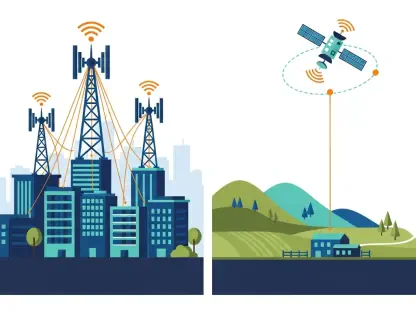In the ever-evolving telecommunications industry, artificial intelligence (AI) holds the promise of revolutionizing operations, from network optimization to customer service enhancements, yet a staggering reality looms large as an overwhelming majority of AI pilot projects—reportedly as high as 95%—fail to move beyond initial testing phases into full-scale deployment. This stark statistic underscores a critical disconnect between the ambitious visions for AI integration and the tangible benefits achieved on the ground. Telecom companies are grappling with complex challenges that hinder progress, even as market projections point to a potential valuation in the billions over the coming decade. The tension between persistent barriers and transformative opportunities paints a nuanced picture of an industry at a crossroads, eager to harness AI’s power but struggling to overcome deeply entrenched obstacles. This exploration delves into the root causes of scaling failures and the pathways forward.
Unpacking the High Failure Rate of AI Pilots
The telecommunications sector faces a daunting hurdle with the alarming failure rate of AI initiatives, where 95% of pilot projects never reach widespread implementation. A primary culprit lies in the intricate nature of telecom networks, often burdened by legacy systems that predate modern data requirements. These outdated infrastructures clash with the high data demands of AI algorithms, particularly in applications like predictive maintenance and real-time traffic analysis. Fragmented data silos compound the issue, as disparate systems prevent the seamless integration needed for effective AI training. Furthermore, poor data quality—often a remnant of decades-old, incompatible telemetric records—creates a bottleneck in developing accurate models for fault detection and network forecasting. This technical quagmire reveals a fundamental mismatch between existing frameworks and the sophisticated needs of AI, stalling progress at the pilot stage and leaving operators searching for viable solutions to bridge this gap.
Beyond the technical realm, regulatory and ethical challenges add layers of complexity to AI adoption in telecom. Stringent privacy laws pose significant constraints, especially for customer-facing tools like chatbots that aim to deliver personalized experiences. Without robust governance frameworks, the risk of data breaches looms large, potentially inviting regulatory scrutiny and derailing deployment timelines. Industry experts warn that failing to address these concerns could erode public trust and slow the pace of innovation. Moreover, ethical considerations around data usage demand careful navigation to ensure compliance while still leveraging AI’s potential for operational gains. This multifaceted landscape of non-technical barriers often catches companies off guard, as the focus on technological solutions overshadows the equally critical need for policy and ethical alignment. The interplay of these factors underscores why so many initiatives remain confined to experimental phases, unable to achieve the scale necessary for industry-wide impact.
Market Optimism Amidst Scaling Challenges
Despite the sobering statistics on pilot failures, the telecom AI market brims with optimism, fueled by projections of exponential growth in the coming years. Analysts estimate a dramatic surge, with market value expected to climb from current figures to as much as $14.5 billion by 2033. This growth trajectory is driven by promising use cases such as predictive analytics, which can enhance network reliability, and revenue-generating applications that capitalize on personalized customer experiences. Regions like North America and Asia-Pacific are poised to lead this charge, leveraging advanced infrastructure and high demand for innovative solutions. The rollout of 5G networks further amplifies this potential, as AI becomes integral to managing complex network slicing and enabling zero-lag applications for the Internet of Things (IoT). Such forecasts paint a picture of an industry on the cusp of transformation, provided it can navigate the scaling hurdles that currently impede progress.
Strategic moves by industry players also signal a shift toward realizing this market potential, even as challenges persist. Some leading telecom operators are consolidating AI efforts into dedicated units, adopting a “company-in-company” model to streamline innovation and focus on autonomous agents for tasks like botnet detection and traffic forecasting. This approach aims to foster agility and prioritize high-impact areas, with ambitious sales targets reflecting confidence in AI’s long-term value. In Europe, where profitability pressures loom large, AI is increasingly seen as a lifeline for cost reduction and efficient network maintenance, especially amid 5G deployments. However, limited earnings may constrain investments in essential skills and tools, creating a delicate balancing act. These strategic pivots highlight a growing recognition that scaling AI requires not just technological fixes but also organizational restructuring and a commitment to aligning resources with long-term goals.
Pathways to Overcoming Barriers
Addressing the scaling crisis in telecom AI demands a multifaceted approach, starting with a concerted effort to modernize infrastructure and tackle data legacies. Legacy systems, often incompatible with AI’s data-intensive needs, must be overhauled or integrated with newer platforms to support seamless data flow. Solutions like edge computing are gaining traction, offering a way to mitigate latency issues by processing data closer to the source, thus enhancing real-time applications. Improving data quality is equally critical, requiring investments in cleansing and standardizing telemetric records to ensure AI models deliver accurate insights. Such technological upgrades are not merely optional but foundational to transitioning pilots into full-scale deployments. Without addressing these core issues, the industry risks perpetuating a cycle of promising starts and stalled outcomes, unable to capitalize on AI’s transformative potential.
Equally important is the cultural and operational shift needed to embed AI into the fabric of telecom operations. Beyond hardware and software, success hinges on fostering an AI-centric mindset across organizations, which includes training workforces to handle the demands of advanced networks like 5G. Building trust through ethical AI implementation is paramount, as is navigating regulatory landscapes with strong governance to prevent setbacks. Social media discussions highlight enthusiasm for AI’s ability to automate field operations, such as optimizing technician routes and reducing repair times, ultimately boosting customer satisfaction. Yet, realizing these benefits requires a commitment to skill development and cross-departmental collaboration. Industry voices stress that preparing for future demands—whether through IoT integration or enhanced customer tools—depends on aligning human capital with technological advancements, ensuring that AI becomes a core driver of innovation rather than a peripheral experiment.
Reflecting on Lessons for Future Success
Looking back, the telecommunications industry’s journey with AI reveals a landscape marked by ambitious pilots that often stumbled at the scaling stage due to entrenched technical and regulatory barriers. The high failure rate of initiatives underscores the pitfalls of mismatched infrastructure and inadequate data readiness, while ethical concerns highlight the need for robust oversight. Despite these struggles, market optimism persists, driven by projections of substantial growth and strategic reorganizations that aim to prioritize AI’s role in cost efficiency and network reliability. Reflecting on this period, it becomes evident that success demands more than technological innovation; it requires a holistic rethinking of operational models and workforce capabilities. Moving forward, telecom operators need to focus on actionable steps—modernizing systems, enhancing data integrity, and fostering an AI-ready culture—to transform past challenges into stepping stones for a future where AI can drive billions in value and redefine industry standards.









